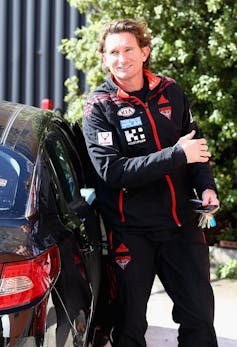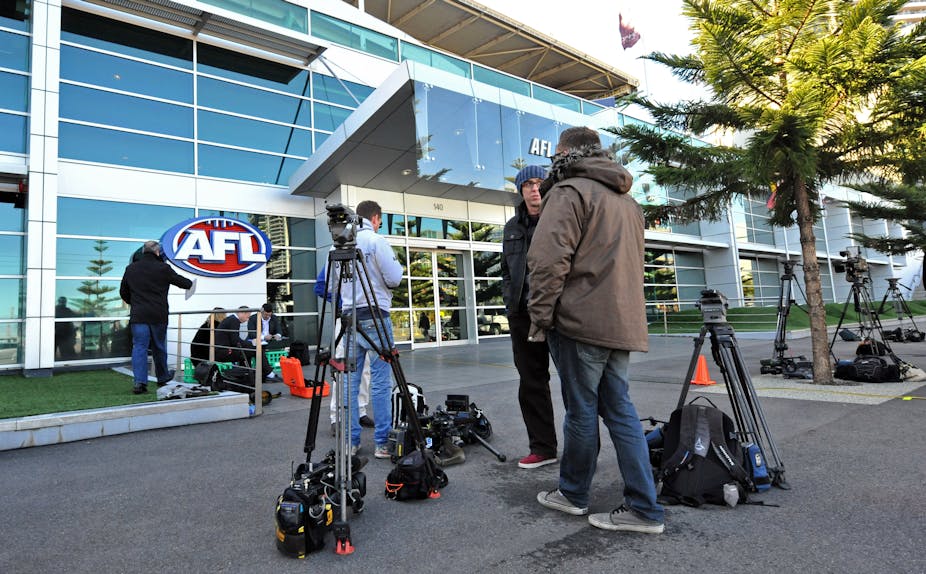As I write, the front pages of Melbourne’s newspapers this morning scream in chorus: Charged: Bombers Drug Scandal. But is this really the worst “scandal” in footy history?
My first lesson in football scandals came early. We shared a house in inner Melbourne with an ex-VFL player. Let’s call him Sam. And let’s not judge him. He worked as a wharfie. Football and running were his tickets to modest prosperity and he knew when to play dead to help the bookies.
Sam was part of a subculture in Australian football in the late 1910s and early 1920s. He and five other players were cleaned out by a new coach, and his club then played better for it.
Sam’s case raises the question of how we ought to govern this wonderful game of ours, a game that gives hope and joy to people year in, year out.
Is the Essendon doping scandal the worst we have seen? Commentators have made their lists of previous scandals. North Melbourne captain Wayne Carey’s affair with the wife of his team’s vice-captain. Carlton and Brisbane player Brendon Fevola’s string of indiscretions (Fevola means “fairytale” in Italian, so the warning was there for all to see). The always controversial Jason Akermanis’ comments on homosexuals. Racist taunts from several players.
But these are cases of individual players taking their transgressive behaviours, so useful on the footy field, out into public places where the damage was done.
A genuine scandal is a collective contrivance by a group of officials, players and others to win an unfair advantage.
Scandal #1: Payments to players, from 1897
The AFL’s predecessor body, the VFL, itself began life in what the football administrators of the day thought was scandalous behaviour: paying players.
The year was 1896. The eastern colonies of Australia were in an economic recession. Across the western world there was a contest between amateur and professional sports bodies. The modern Olympic Games were begun that year as a display of amateur sporting prowess.
Several Victorian football clubs decided to break away from the ostensibly amateur league, the Victorian Football Association (VFA), in defiance of its chief, T.S. Marshall. Marshall, headmaster of one of Melbourne’s prestigious elite boys’ schools, always argued that payments to players would destroy the gentlemanly quality of the game.
The governance problem here was that power lay not with the football leagues, but with the cricket clubs who owned the grounds on which they played and drew on the football crowds for their revenue.
Scandal #2: Boycotting a finals match, 1904
One of the remnant clubs that continued in the VFA, Richmond (which would join the professional league a few seasons later), refused to play in a finals match against North Melbourne. Some say this was because they did not trust a particular umpire; others because North Melbourne and its fans were extremely violent.
Whatever Richmond’s motivation, this refusal impeded the efforts of the VFA to create a viable finals system at the end of the regular season. With no such club boycotts, the VFL went on to build what has become their marquee event, the September finals.
The governance problem here was the existence of two competing football leagues with quite different business models.
Scandal #3: Playing ‘dead’, 1919-1924
My friend Sam was not alone. The 1922 VFA Grand Final was marred by allegations of bribes paid by Footscray’s ex-player Vernon Banbury to members of the Port Melbourne side. Banbury was disqualified for life by the VFA. Footscray retaliated by making him a life member of their club.
Two seasons later there was a celebrated match between the two winning sides of the rival leagues, Footscray from the VFA and Essendon from the VFL. Essendon, the “Same Olds” were accused of playing dead to cause an upset win for the “Tricolours” of Footscray. Within a season, Footscray had switched over from the VFA to the VFL (with Hawthorn and North Melbourne).
Here, the governance problem was the absence of a government-controlled betting institution.
Scandal #4: Poaching players from other Australian leagues, 1933

Although there were many examples of Victorian players moving to South Australia and Western Australia as early as the 1890s - partly to chase work on the Kalgoorlie goldfields - by the depression of the 1930s, the poaching of top players by VFL clubs had become an art form.
Western Australians and South Australians began a long tradition of resentment against what later became called the “Big V” from this period. The climax was the all-conquering South Melbourne team of 1933, comprised so many outsiders it was called the Foreign Legion side. South would not win another flag – as Sydney – for eight decades.
This scandalous behaviour reflected the weak governance structures of the day, with so much power in the hands of the VFL vis-à-vis the other state league competitions.
Scandal #5: Fitzroy, 1996
After South Melbourne moved to Sydney in 1981 and the proposed mergers of Footscray and Fitzroy and Melbourne and Hawthorn failed, in 1996 Fitzroy was forcibly merged with Brisbane.
The option of being relegated to the reserves - later to become the new VFL, with other junior clubs from the previous VFA - was not offered to them.
Scandal #6: Salary cap infringements, 1987-2012
Prior to the formation of a national football league in 1990, the AFL introduced a national draft and a cap on the total salary that each club could spend. “Tanking” to gain priority draft picks and the use of covert payments were temptations for all clubs.
There have been 28 occasions when clubs (indeed, most clubs) have been found guilty of salary cap infringements of one kind or another. The punishments have been fines made against club officials, and no premiership points have ever been deducted.
Earlier this year, Melbourne officials were found guilty of bringing the game into disrepute, even though claims of tanking during the 2009 season were not proven.
Plus ça change?
Were he alive today, my friend Sam would smile knowingly to himself as he read this morning’s papers, knowing that scandal has never truly left the now-ultra professional world of Australian rules footy.

